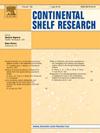Comparing and improving different methods to quantify silt and clay abundance within estuarine mud
IF 2.2
3区 地球科学
Q2 OCEANOGRAPHY
引用次数: 0
Abstract
Estuarine mud (also referred to as “fine-material”) is comprised of clay and silt particles, whose settling velocity differs by up to four orders of magnitude. Hence, quantifying their relative abundance within the mud fraction is key to understand and predict estuarine mud dynamics. Here we improve this quantification, using mud from two differing estuaries, one with a low clay-mud ratio (Massachusetts, northeast coast of USA) and one with a high clay-mud ratio (South Carolina, southeast coast of USA). First, we compare four different laboratory methods (XRD, laser diffraction, pipette method, Owen tube) to estimate the clay-mud ratio. Estimates based on laser diffraction are confounded by the fact that particles in the 2–30 μm size class could be either silt or “hyper-stable clay aggregates”, but this can be resolved by using the particle size distribution of pure clay as a reference. With this correction, laser diffraction agrees with the other three methods. Second, we show that optical backscatter (turbidity) and acoustic backscatter provide – at least under laboratory settings – a good estimate of suspended clay and silt, respectively. These two measurements correctly estimate the clay-mud ratio of the two samples, and also provide an estimate of silt and clay settling velocity in still water. These velocities are consistent with those from standard settling tests (Owen tube). Turbidity and acoustic backscatter should be able to monitor suspended clay and silt concentration in the field, provided that sand is negligible.
比较和改进不同方法量化河口泥中粉砂和粘土丰度
河口泥(也被称为“细物质”)由粘土和淤泥颗粒组成,其沉降速度相差高达四个数量级。因此,量化它们在泥浆组分中的相对丰度是理解和预测河口泥浆动力学的关键。在这里,我们改进了这一量化,使用来自两个不同河口的泥浆,一个具有低粘土-泥浆比(马萨诸塞州,美国东北海岸),另一个具有高粘土-泥浆比(南卡罗来纳州,美国东南海岸)。首先,我们比较了四种不同的实验室方法(XRD,激光衍射,移液法,欧文管)来估计粘土-泥浆比。2-30 μm粒径的颗粒可能是粉砂或“超稳定粘土团聚体”,这一事实使基于激光衍射的估计混淆,但这可以通过使用纯粘土的粒径分布作为参考来解决。通过这种修正,激光衍射与其他三种方法一致。其次,我们表明光学后向散射(浊度)和声学后向散射(至少在实验室设置下)分别提供了悬浮粘土和淤泥的良好估计。这两个测量正确地估计了两个样品的粘土-泥浆比,也提供了淤泥和粘土在静水中沉降速度的估计。这些速度与标准沉降试验(欧文管)的结果一致。浊度和声波后向散射应该能够监测现场的悬浮粘土和淤泥浓度,前提是沙子可以忽略不计。
本文章由计算机程序翻译,如有差异,请以英文原文为准。
求助全文
约1分钟内获得全文
求助全文
来源期刊

Continental Shelf Research
地学-海洋学
CiteScore
4.30
自引率
4.30%
发文量
136
审稿时长
6.1 months
期刊介绍:
Continental Shelf Research publishes articles dealing with the biological, chemical, geological and physical oceanography of the shallow marine environment, from coastal and estuarine waters out to the shelf break. The continental shelf is a critical environment within the land-ocean continuum, and many processes, functions and problems in the continental shelf are driven by terrestrial inputs transported through the rivers and estuaries to the coastal and continental shelf areas. Manuscripts that deal with these topics must make a clear link to the continental shelf. Examples of research areas include:
Physical sedimentology and geomorphology
Geochemistry of the coastal ocean (inorganic and organic)
Marine environment and anthropogenic effects
Interaction of physical dynamics with natural and manmade shoreline features
Benthic, phytoplankton and zooplankton ecology
Coastal water and sediment quality, and ecosystem health
Benthic-pelagic coupling (physical and biogeochemical)
Interactions between physical dynamics (waves, currents, mixing, etc.) and biogeochemical cycles
Estuarine, coastal and shelf sea modelling and process studies.
 求助内容:
求助内容: 应助结果提醒方式:
应助结果提醒方式:


